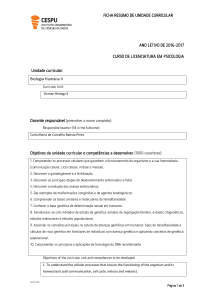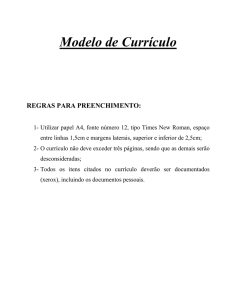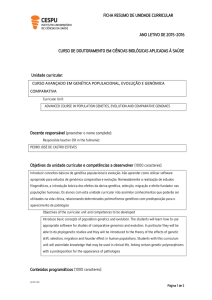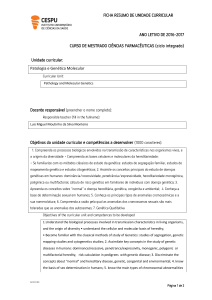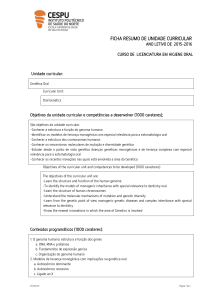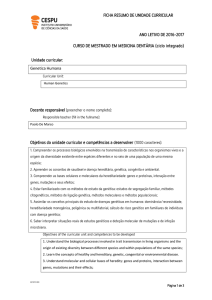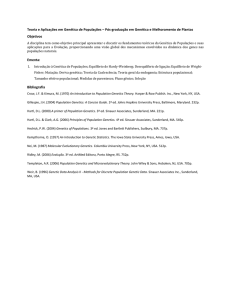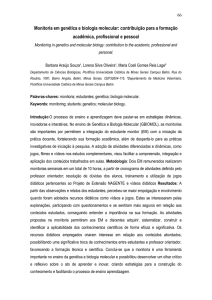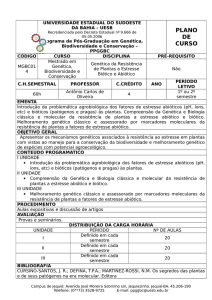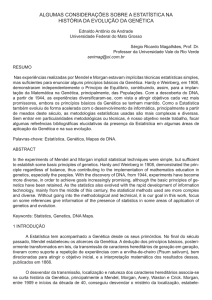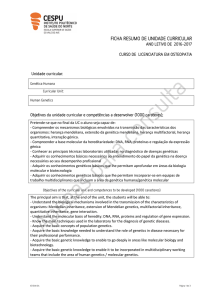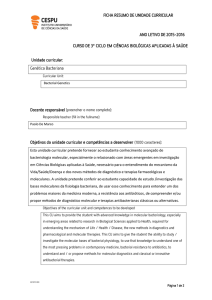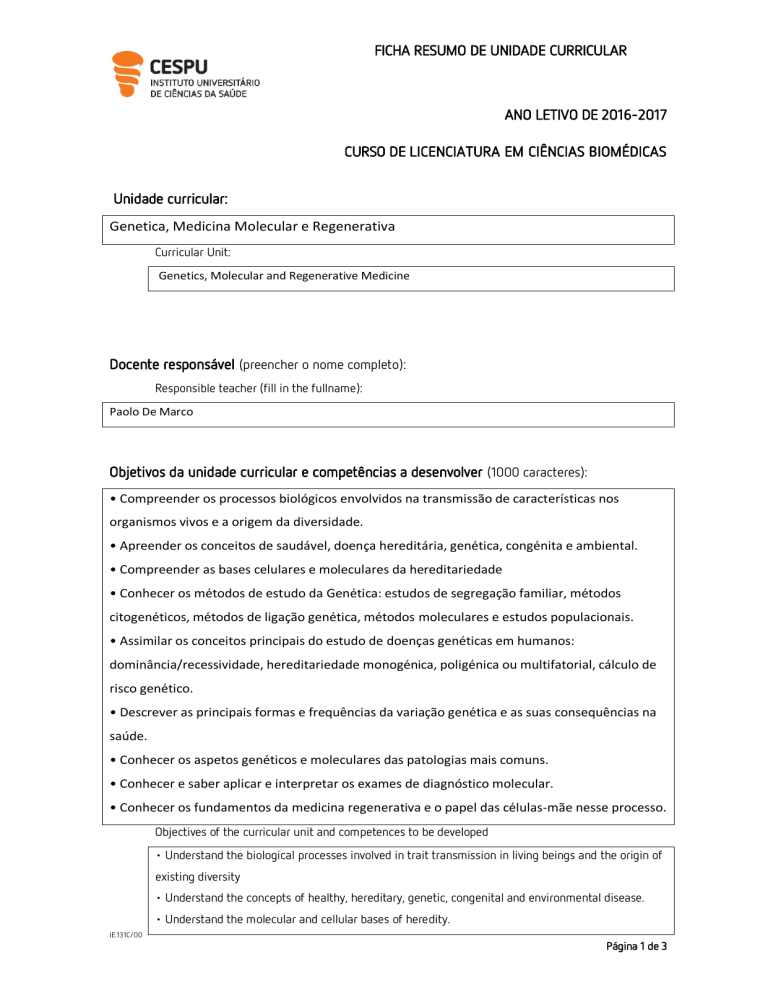
FICHA RESUMO DE UNIDADE CURRICULAR
ANO LETIVO DE 2016-2017
CURSO DE LICENCIATURA EM CIÊNCIAS BIOMÉDICAS
Unidade curricular:
Genetica, Medicina Molecular e Regenerativa
Curricular Unit:
Genetics, Molecular and Regenerative Medicine
Docente responsável (preencher o nome completo):
Responsible teacher (fill in the fullname):
Paolo De Marco
Objetivos da unidade curricular e competências a desenvolver (1000 caracteres):
• Compreender os processos biológicos envolvidos na transmissão de características nos
organismos vivos e a origem da diversidade.
• Apreender os conceitos de saudável, doença hereditária, genética, congénita e ambiental.
• Compreender as bases celulares e moleculares da hereditariedade
• Conhecer os métodos de estudo da Genética: estudos de segregação familiar, métodos
citogenéticos, métodos de ligação genética, métodos moleculares e estudos populacionais.
• Assimilar os conceitos principais do estudo de doenças genéticas em humanos:
dominância/recessividade, hereditariedade monogénica, poligénica ou multifatorial, cálculo de
risco genético.
• Descrever as principais formas e frequências da variação genética e as suas consequências na
saúde.
• Conhecer os aspetos genéticos e moleculares das patologias mais comuns.
• Conhecer e saber aplicar e interpretar os exames de diagnóstico molecular.
• Conhecer os fundamentos da medicina regenerativa e o papel das células-mãe nesse processo.
Objectives of the curricular unit and competences to be developed
• Understand the biological processes involved in trait transmission in living beings and the origin of
existing diversity
• Understand the concepts of healthy, hereditary, genetic, congenital and environmental disease.
• Understand the molecular and cellular bases of heredity.
IE.131C/00
Página 1 de 3
FICHA RESUMO DE UNIDADE CURRICULAR
• Become familiarized with the methods used in studying genetics:
family segregation studies, cytogenetic methods, genetic linkage methods, molecular methods and
population studies.
• Assimilate the main concepts on the study of genetic diseases in humans: dominance/recessivity,
single-gene inheritance, polygenic and multifactorial inheritance, genetic risk calculation.
• Describe the main forms and frequencies of genetics variation and its consequences on health.
• Know the genetic and molecular aspects of the most common pathologies.
• Know and be able to apply and interpret molecular diagnostic exams.
• Know the fundamentals of regenerative medicine and the role of stem cells in this process.
Conteúdos programáticos (1000 caracteres):
Programa teórico
1.Introdução
2. Genética mendeliana
3. Extensões da genética mendeliana
4. Genética quantitativa
5. Ligação e mapeamento cromossómico
6. Heterossomas e determinação sexual
7. Anomalias cromossómica
8. Mutação génica e reparação do ADN
9. Genética de populações
10. Genética do cancro
11. Fundamentos da medicina regenerativa e papel das células-mãe.
Programa prático-laboratorial:
1. Tecnologia genética e suas aplicações
2. Construção de pedigrees para a capacidade de sentir o sabor da feniltiocarbamida
3. Isolamento de DNA genómico e determinação da sua pureza
4. Isolamento de DNA plasmídico + restrição
5. Eletroforese em gel de agarose e interpretação dos resultados
6. Diagnóstico por RSP / PCR-RFLP
7. Isolamento de RNA; quantificação e determinação da sua pureza. Preparação de cDNA
8. Fingerprinting molecular
9. Espalhamento de cromossomas e bandeamento G; análise dos cariótipos
10. Journal club.
Syllabus
Theoretical syllabus:
IE.131C/00
Página 2 de 3
FICHA RESUMO DE UNIDADE CURRICULAR
1. Introduction
2. Mendelian genetics
3. Extensions of mendelian genetics
4. Quantitative genetics
5. Linkage and chromosome mapping
6. Heterosomes and sex determination
7. Chromosome anomalies
8. Gene mutation and DNA repair
9. Population genetics
10. Cancer genetics
11. Bases of regenerative medicine and the role of stem cells.
Practical syllabus:
1. Gene technology and its applications
2. Pedigrees for the ability to feel phenylthiocarbamide taste
3. Isolation of genomic DNA and determination of its purity
4. Isolation of plasmid DNA and restriction
5. Electrophoresis in agarose gel and interpretation of results
6. Diagnostic test by RSP / PCR-RFLP
7. Isolation of RNA; quantification and determination of its purity. cDNA preparation.
8. Molecular fingerprinting
9. Chromosome spread and G-banding; analysis of karyotypes
10. Journal club.
Referências bibliográficas (bibliography)
(máximo três títulos):
1 - Concepts of Genetics (9th Ed.) William S. Klug, Michael R. Cummings, Charlotte Spencer, Michael A.
Palladino (2009). Benjamin Cummings/Prentice Hall. ISBN:0-321-52404-7
2 - Student Handbook and Solutions Manual for Concepts of Genetics, (9th Ed.) William S. Klug, Michael R.
Cummings, Charlotte Spencer, Michael A. Palladino, Harry Nickla (2009). Benjamin Cummings/Prentice Hall.
ISBN-13: 9780321544605
3 - Manual de Genética Médica (1ª Ed.). Regateiro F. J. (2003). Imprensa da Universidade de Coimbra (2ª
Reimpressão – 2007). ISBN: 972-8704-12-7
O regente: (data e nome completo):
IE.131C/00
Página 3 de 3

